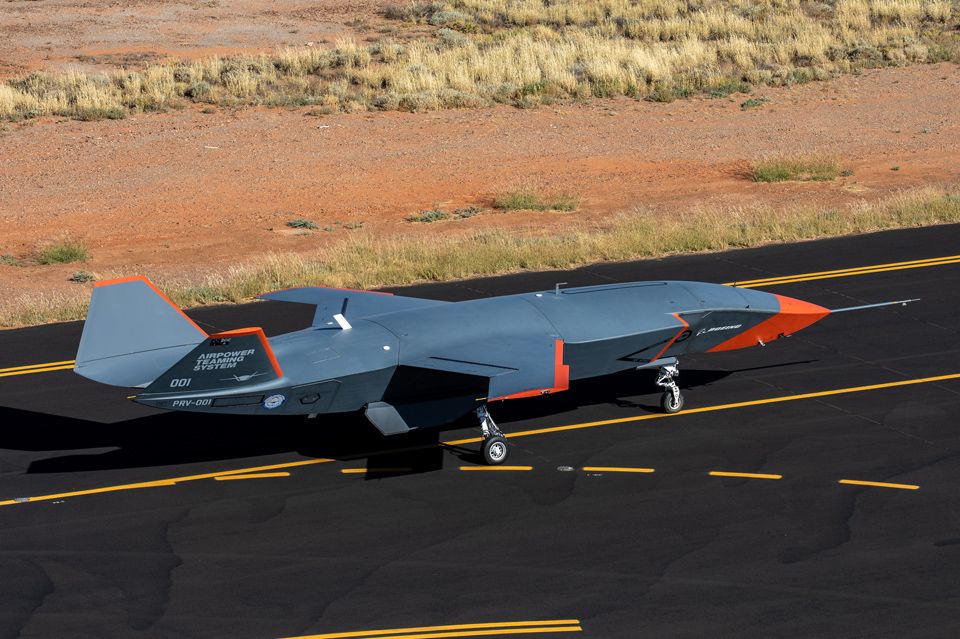Boeing and the Royal Australian Air Force have successfully completed the first test flight of a Loyal Wingman uncrewed drone.
The drone is one of three prototypes that will be developed as a part of the Loyal Wingman program, which is one of the most advanced projects in the world to develop a manned-unmanned teaming (MUM-T) concept. Mostly being developed for military applications, MUM-T concepts involve a drone supporting and extending a piloted aircraft during missions.
Several manned-unmanned teaming (MUM-T) concepts are being developed for military applications, including the Grom unmanned combat aerial vehicle in Russia. MUM-T concepts involve a drone supporting and extending a piloted aircraft during missions.
Several MUM-T concepts are being developed for military applications around the world, including the Grom unmanned combat aerial vehicle in Russia. QinetiQ and the UK’s defence research agency demonstrated a teaming flight in August 2020.
The Loyal Wingman drone is designed to provide fighter-like performance and measures 38ft long (11.7m) with a range of more than 2,000 nautical miles The prototype is the first military aircraft to be entirely designed and manufactured in Australia in more than 50 years.
Following a series of taxi tests validating ground handling, navigation and control and pilot interface, the aircraft completed a successful takeoff under its own power before flying a pre-determined route at different speeds and altitudes to verify flight functionality and demonstrate the performance of the Airpower Teaming System design.
The test flight was conducted under the supervision of a Boeing test pilot monitoring the aircraft from a ground control station at the Woomera Range Complex.
Air Vice-Marshal Cath Roberts, Royal Australian Air Force (RAAF) head of air force capability said,“The Loyal Wingman’s first flight is a major step in this long-term, significant project and we’re thrilled to be a part of the successful test.
“The project is a pathfinder for the integration of autonomous systems and artificial intelligence to create smart human-machine teams. Through this project we are learning how to integrate these new capabilities to complement and extend air combat and other missions,” she said.
Boeing Defense, Space & Security’s president and CEO Leanne Caret said, “We’re honored to be opening this part of aviation’s future with the Royal Australian Air Force and we look forward to showing others how they also could benefit from our loyal wingman capabilities.”
The Loyal Wingman program has so far needed more than 35 Australian industry teams working with Boeing. Development of the aircraft started in 2018 and the team used model-based engineering techniques, such as digitally flight-testing digital twins of the aircraft,
Teaming flights with additional Loyal Wingman aircraft are scheduled to take place later this year. Boeing engineers in Australia successfully conducted the first teaming test flights with a set of drones in December last year.

Following the successful flight, the Australian government and Boeing announced they are to develop a further three Loyal Wingman aircraft. The agreement means six Loyal Wingman aircraft will be prouced for the RAAF over the next three years at a cost of US$115 million.
The contract agreed supports the maturation of the aircraft design, evolution of current and future payloads, and create the sustainment system for the aircraft in operations. It will also advance Airpower Teaming System advanced concepts through digital testing and demonstration.
“In addition to progressing the air vehicle design and support system, we will further develop the aircraft’s mission system including advanced AI decision-making capabilities and new payloads,” said Dr. Shane Arnott, program director of the Boeing Airpower Teaming System.
“Continued digital engineering and significantly expanded live testing of the system will provide RAAF and Boeing with the ability to jointly take the concept to the next level, activities that are critical for us to rapidly understand how the Airpower Teaming System can be employed in the future battlespace.”




